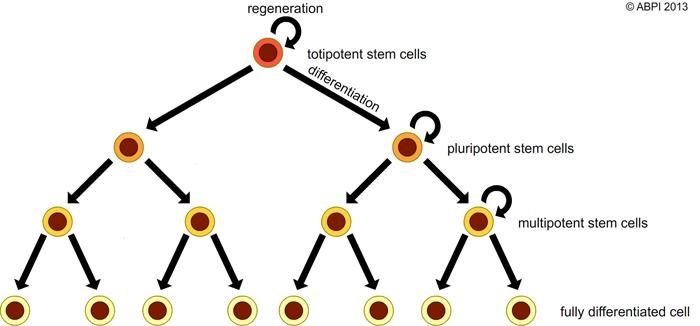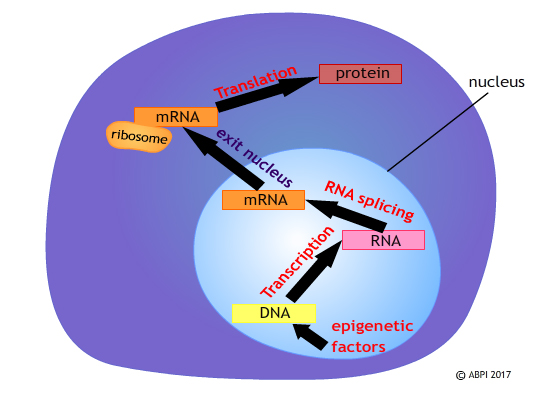This topic takes on average 55 minutes to read.
There are a number of interactive features in this resource:
 Biology
Biology
The early human embryo contains many stem cells. Stem cells are undifferentiated themselves, but have the potential to develop into many different types of specialised cells. The very earliest cells in an embryo are known as totipotent – they have the potential to develop into any one of the different types of cells needed to make a complete human being. By the time the embryo is four or five days old and has formed a hollow ball of cells the stem cells are slightly less flexible. They are pluripotent – they can form almost all of the cell types needed in future, but not tissue such as the placenta. The adult stem cells found in adult human beings are only multipotent – they are partly differentiated already and can only form a relatively limited number of cell types.
The process by which an unspecialised stem cell becomes a cell with a specific structure and function is known as differentiation. Differentiation is genetically controlled: an undifferentiated cell can potentially express (produce proteins from) all the genes in its DNA. As the cell becomes differentiated, some genes are switched off and can no longer be expressed. The specific pattern of which genes are switched on and which are switched off produces a differentiated cell type with a specific function. The proteins that cell is able to produce relate to its function: a differentiated cell doesn’t produce proteins that it doesn’t need.
A cell can be partly differentiated but can still differentiate further to form other cells. Think of cell differentiation as a pyramid: as you go down the pyramid cells become more specialised and less able to generate other cells, with fully differentiated cells with a specific function and unable to form any other types of cell at the bottom.

Scientists can measure the degree of differentiation between cells by comparing the proteins they produce. Almost all cells have a number of what are known as ‘house-keeping proteins’ in common – these are the enzymes and structures needed for the basic functions of life. The level of differentiation in cells can be indicated by the proteins they express. This can also be used to work out which genes have been expressed and which have been suppressed or switched off. In humans, the cells of the testes produce the biggest variety of proteins – 999 proteins on top of the normal housekeeping proteins - whilst the cerebrum of the brain expresses 318 extra proteins.
You can find out more about the process of protein synthesis here.
Gene expression involves at least three processes:
transcription of the DNA to mRNA
translation from mRNA to proteins
modification of proteins after synthesis
Exerting control at any of these stages gives control over the expression of a gene. The most common way of affecting gene expression and bringing about cell differentiation is by switching genes on or off, controlling which genes are transcribed and so which proteins are made.

The transcription of the DNA itself may be affected by transcription factors in a number of different ways
transcription factors may switch on a gene, stimulating the start of the transcription of a particular region of DNA
transcription factors may make the structure of the chromatin more or less open to RNA polymerase, stimulating or preventing the transcription of a particular region of DNA and so switching a gene on or off
one transcription factor can affect a number of genes in different ways, switching some genes on and some genes off.
The initial mRNA is a transcription of all of the DNA, including the introns or non-coding regions of DNA. It needs to be modified before it is transported to the ribosomes for translation. The introns are removed by enzymes called spliceosomes. Sometimes spliceosomes join some of the exons, or coding regions, in different sequences so the same region of DNA can result in several different types of mRNA, coding for different proteins.
Epigenetics is a relatively new way of looking at the effect of the environment on the genome. It describes how different chemicals associated with the DNA or RNA can affect the way the genetic code is read. This external control of the genome may be brought about by:
DNA methylation – silencing or switching off a gene or gene sequence. DNA methylation can also affect the histone arrangement, an alternative mechanism for affecting DNA transcription. DNA demethylation has the opposite effect and activates or switches on a silenced gene.
Histone modification – the addition or removal of different groups from histones makes the heterochromatin structure more or less open. This affects whether the DNA can be transcribed or not. The histones can be modified in a number of ways including levels of histone acetylation – the addition of an acetyl (ethanoyl) group - and histone methylation.
Non-coding RNA – only about 2% of the transcribed RNA actually codes for proteins. It appears that much of the non-coding RNA (ncRNA) regulates transcription of the DNA directly or by histone modification, or modifies the products of transcription.
Some proteins are produced in an inactive form. After they have been produced, post-translational changes are needed before they become functional. This may be the result of second messengers such as cyclic AMP (cAMP) in the cell, or specific enzymes in the body, which modify and activate the proteins, changing the molecule produced. Examples are the production of fibrin from fibrinogen in the clotting cascade and the production of pepsin from pepsinogen in the digestive system.
You can find out more about the factors affecting gene expression here.